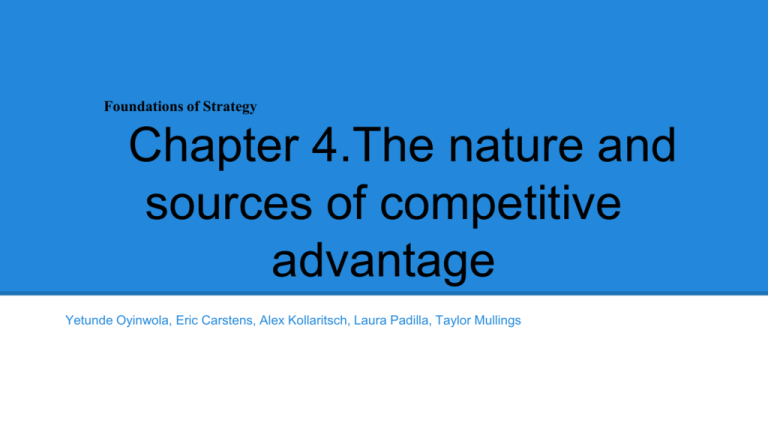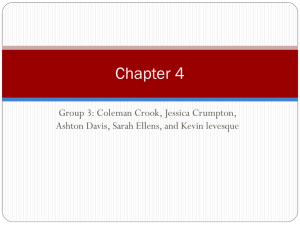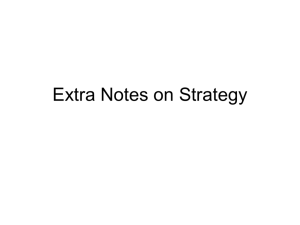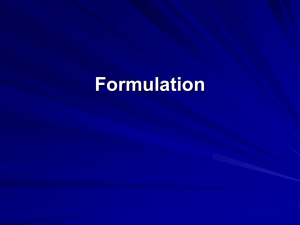Foundations of Strategy Chapter 4.The nature and sources of
advertisement

Foundations of Strategy Chapter 4.The nature and sources of competitive advantage Yetunde Oyinwola, Eric Carstens, Alex Kollaritsch, Laura Padilla, Taylor Mullings Objectives • • • • • • Understand the term “Competitive Advantage” Predict potential for competition to wear away competitive advantage Recognize how resource conditions create imperfections in the competitive process that offer opportunities for competitive advantage Distinguish the two primary types: cost advantage and differentiation advantage Use value chain framework to analyse potential sources of cost and differentiation advantage to recommend strategies for enhancing competitiveness Appreciate the pitfalls of being ‘stuck in the middle’ and the challenge of achieving effective differentiation and low cost Opening Case: Singapore Airlines • • • • • ‘World’s Best Airline’ by Conde Nast Traveler Ranked 27th in Fortune Magazine’s ‘World’s Most Admired Companies’ 2010 Based on two main strategies: its planes and its people Planes o ‘Young’ fleets o First airline to launch Airbus A380 o Cost Advantage People o Attracts first class university graduates o 110 hours of retraining for every employee annually o Focus on customer service o Differentiation Advantage Emergence of Competitive Advantage How does competitive advantage emerge? External sources of change ● Changing customer demand ● Changing Prices ● Technological change Resource heterogeneity among firms means differential impact Some firms faster and more effective in exploiting change Internal sources of change Some firms have greater creative and innovative capability C.A From Responsiveness to Change Involves one of two key capabilities: • • The ability to anticipate changes in the external environment Speed Markets have become turbulent and unpredictable, so speed of response through greater flexibility has become increasingly important Two requirements for quick response: • • Information Short cycle times Competitive Advantage from Innovation Innovation generates changes that create competitive advantage. ➢ Overturns other firms competitive advantages Strategic innovation: a new approach to doing business including new business models ➢ ➢ ➢ Novel products Experiences Modes of product delivery Novel Organisational Designs Southwest Airlines ➢ ➢ ➢ ➢ Point-to-point No frills airlines service Single type plane Flexible non-union employees. Apple ➢ Reinvention of record music ➢ iTunes ➢ New product launch Pioneering Dimensions of Strategy ➢ New industries ○ Xerox: plain-paper copier industry ➢ New customer segments ○ VCRs and video cassette ○ Xbox ➢ New sources of competitive advantage ○ Cirque du soleil ○ Dell Sustaining Competitive Advantage Imitation is the most direct form of competition; for long term sustainability barriers to imitation must exist. Sources of isolating mechanisms ➢ Identification ➢ Incentive ➢ Diagnosis ➢ Resource acquisition Identification: Obscuring Superior Performance According to George Stalk of BCG, “one way to throw competitors off balance is to mask high performance so rivals fail to see your success until its too late”. ➢ Dominate a niche market ➢ Remain private: avoid disclosing financial performance PepsiCo “Power of One” ➢ Introduced in September, 2011 ➢ Full coordination across the food and beverage operating systems. ○ Unlock opportunities and create value across the business. ➢ Long-term strategy to strengthen and extend global leadership position in snacks and leverage the power of PepsiCo combined food and beverage businesses. ○ Help extend competitive advantage around the world Deterrence and Pre-emption If a firm can persuade rivals that imitation will be unprofitable, it may be able to avoid competitive challenges. • Proliferation of product varieties by a market leader • Large investments in production capacity ahead of growth of demand • Patent proliferation Diagnosing Competitive Advantage If a firm is to imitate the competitive advantage of another, it must understand the basis of its rival’s success. • Causal Ambiguity: The more multidimensional a firm’s competitive advantage, the more difficult it is to diagnose the determinants for success • Uncertain Imitability: Where there is ambiguity, imitation leads to uncertain success Acquiring Resources and Capabilities •The imitator can mount a competitive challenge only if they can assemble the required resources •Imitation is fast when the competitive advantage does not require complex, firm-specific resources •First-mover advantage: Where the initial occupant of a strategic position gains access to resources and capabilities that a follower cannot match Ex: Urban Outfitters •Self description: “Targeting well-educated, urban-minded, young adults aged 18-30 through its unique merchandise mix and compelling store environment.” •Each store has a unique design •Store layouts are changed every two weeks to provide a new shopping experience for returning customers •Emphasizes community with its customers through blogs and word-of-mouth transmissions for advertising •Attempts to imitate would likely fail because of the difficulty of replicating every aspect of the strategy then integrating them in the right manner. Is SIA’s Competitive Advantage Sustainable? • Other airlines could invest in new aircraft, staff training, and ticketing and check-in technologies • Culture of cost-effective services is ingrained in the company • They want to be the most profitable rather than the largest airline • Cabin crew members work together for significant periods of time • All of these things put together with the new fleet makes it tough to imitate Sources of Competitive Advantage Strategy and Cost Advantage • Cost Drivers Economies of Scale Economies of Learning Production Techniques Product Design Input Costs Capacity Utilization Residual Efficiency Value Chain Analysis 1. Break down the firm into separate activities. 2. Establish the relative importance of different activities in the total cost of the product. 3. Compare costs by activity. 4. Identify cost drivers. 5. Identify linkages. 6. Identify opportunities for reducing costs. Strategy and Differentiation Advantage Differentiation- capturing a price premium in the market that exceeds the cost of providing the differentiation. Stages of Value Chain Analysis for Differentiation Advantage 1. Construct a value chain for the firm and the customer 2. Identify the drivers of uniqueness in each activity a. b. Examine each activity in the firms value chain Identify variables that contribute to uniqueness Stages of Value Chain Analysis... 3. Selecting the most promising differentiation variables for the firm a. Greatest potential for differentiation b. Identify linkages between activities c. Sustainability Stages of Value Chain Analysis... 4. Locate linkages between the value chain of the firm and that of the buyer a. Create value for the consumer b. Reorganize product distribution i. Proctor and Gamble Singapore Airlines’ Value Chain Analysis Porter’s Generic Category Example Differentiation Initiatives Operations Ticketing, Flight Scheduling Employs more cabin crew than other airlines = more personal attention Outbound Logistics Flight connections, partnerships Introduced non-stop business class only service between Singapore and NY Service Pre and post flight service Loyalty marketing Summary • • • • Making money in business requires establishing and sustaining competitive advantage Recognise how resource conditions create imperfection in the competitive process Distinguish two types of competitive advantage: cost advantage & differentiation Use value chain framework to analyse potential sources of cost and differentiation advantage






